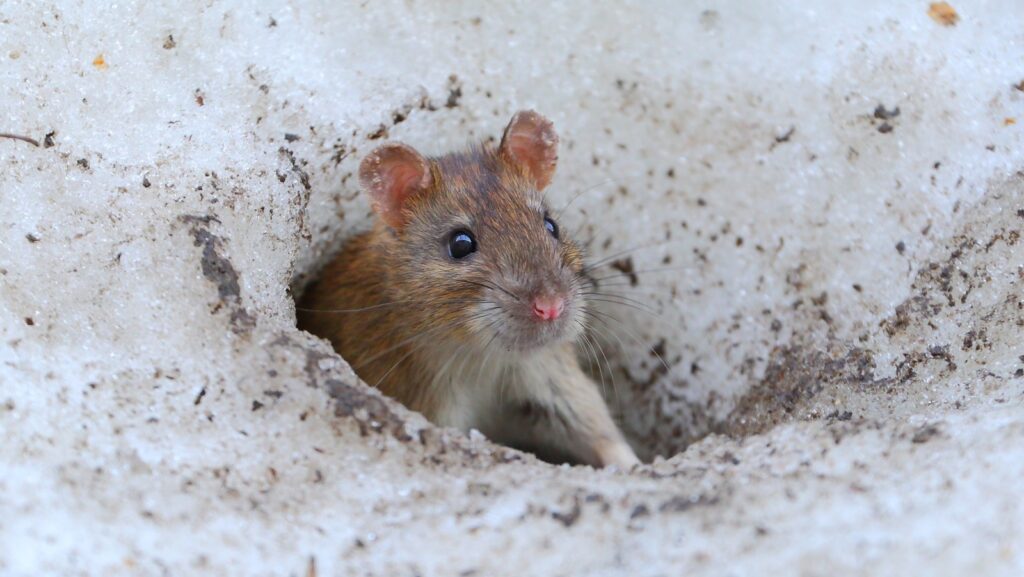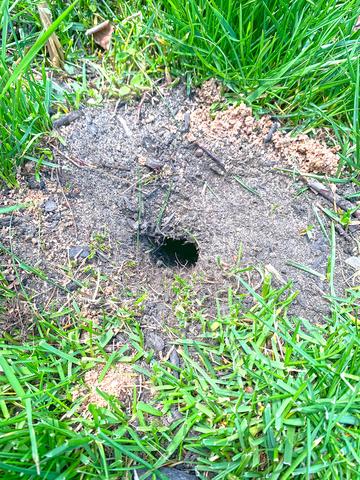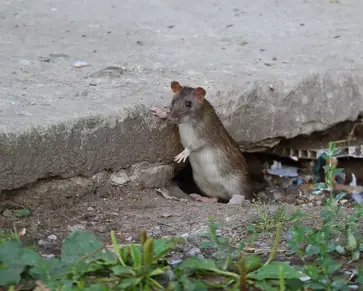
Rats, often portrayed as troublesome pests, occupy a unique niche within the animal kingdom, characterized by their remarkable adaptability and unparalleled survival instincts. In this comprehensive exploration, we invite you to journey into the enigmatic realm of rat burrows, immersing yourself in their intricate behaviors, the challenges posed by the presence of rat holes in your yard, and the arsenal of effective strategies for managing them.

Within the realm of rats, a diverse tapestry of species, from the ubiquitous Norway rat to the elusive black rat, reveals an intriguing array of biological diversity. In our experience providing rat removal services in Dallas, we think that what unites these various rat species is their extraordinary capacity to acclimate to an array of environments. This exceptional adaptability forms the bedrock of their evolutionary triumph as survivors.
At the core of their unparalleled resilience is their omnivorous dietary preference. Rats possess an uncanny ability to consume an assortment of foodstuffs, ranging from grains to discarded remnants pet food, rendering them consummate scavengers. Regrettably, it is this very scavenging proclivity that often leads them to infiltrate your garden, instigating the creation of unsightly rat holes within your yard's confines.
Rats are prolific nest builders, demonstrating a remarkable penchant for craftsmanship. They meticulously fashion snug sanctuaries below the surface, wherein they nurture their furry offspring. These intricately designed rat nests often serve as impregnable fortresses, shielding their progeny from predators and the vagaries of inclement weather.
Rats are consummate foragers, traversing your surroundings with the finesse of silent phantoms. Fueled by an exceptional olfactory prowess and unrivaled agility, rats prefer that they embark on ceaseless quests for sustenance and shelter. Their elusive presence often leaves telltale signs in the form of unmistakable rat holes, serving as a testament to their perpetual search for resources.
A rat burrow is no ordinary cavity in the earth; it represents a labyrinthine subterranean realm of ingenuity. This complex construction comprises distinct components, including a meticulously devised entrance, a nurturing nesting chamber, and an intricate network of escape passages. Each element plays a pivotal role in the rat's overarching strategy for survival.
Rats engage in burrowing activities for multifarious reasons, encompassing protective instincts, reproductive needs, and the imperative to stockpile food resources. Consequently, when they bore into your garden's soil, it serves as a clear indication that they are actively establishing and defending their territorial domain.
Delving deeper into the enigma of rat burrows, we encounter the fascinating phenomenon of species-specific burrowing preferences. Each rat species boasts its own distinctive approach to subterranean architecture.
For example, the Norway rat gravitates towards constructing burrows in close proximity to man-made structures, while the black rat exhibits a proclivity for elevated locations. Discerning these divergent tendencies can be invaluable in identifying the culprits responsible when you stumble upon enigmatic rat holes hidden beneath the ground.

What Rat Holes Bear Recognizing rat holes within your yard is a pivotal initial stride towards efficient control. Rat holes typically manifest as well-defined, rounded apertures, typically measuring between 2 to 4 inches in diameter. When these burrows are freshly excavated, they may exhibit telltale signs such as dislodged soil or distinct digging imprints in their immediate vicinity.
It is an undeniable fact that rats are proficient excavators within garden settings. These garden-based rat holes serve as conspicuous indicators of rat presence. Swift action on rat problem is imperative upon their discovery, as they signify ongoing rat activity and should be promptly addressed to curtail potential harm and further disruption.
The intrusion of rat burrows carries dire consequences for a spectrum of human constructs, including buildings, roadways, and cultivated gardens. Their relentless excavation efforts can undermine foundations and induce structural degradation, presenting a formidable menace to homeowners and property integrity alike.
The Silent Threat Beyond the visible property damage, the presence of rat holes in your yard harbors the insidious potential roof rat in to incubate a host of health-related perils. Rats, as vectors of diverse pathogens, can transform these subterranean abodes into breeding grounds for diseases. This not only endangers the well-being of homeowners but also poses a tangible risk to the health of family members and cherished pets.
Rats as ecosystem disruptors the pernicious influence of rats extends beyond the confines of your home; it reverberates through local ecosystems. Their relentless burrowing endeavors disrupt the intricate balance of these ecosystems, posing a threat to plant roots and indigenous wildlife. This upheaval instigates a chain reaction of ecological imbalances, underscoring the multifaceted impact of rat activity on the environment.

Rats are known for their tunneling and hole-digging activities. These tunnels and holes can vary in size and shape, depending on the rat species and the purpose of the burrow. If you come across mysterious openings in your yard or garden, they could be potential rat tunnels or holes.
Rat holes in your yard can be a cause for concern. These openings for roof rats are often entrances to their burrows, which may lead to a complex underground network. Understanding the signs of rat activity in your yard is essential for effective control measures. As rat removal experts, we recommend that all homeowners stay alert for this kind of sign because if you have rat holes in your yard, it's probably that they find a way into your property.
Yes, we have provided hundreds of rats removals in the Dallas-Fort Worth area, and we can affirm that rats are proficient diggers, and they do indeed dig tunnels as part of their burrowing behavior. These tunnels serve various purposes, including shelter, nesting, and to gain access to food sources.
Rat burrows can vary in appearance, but they often consist of a hole or tunnel entrance leading underground. Inside, you may find a nesting chamber where rats raise their young. The network of rid of rat holes and tunnels can be extensive, depending on the rat population and environmental factors.
The depth of rat burrows can vary, but they are typically not very deep, often ranging from a few inches to a few feet underground. The depth may be influenced by factors such as soil type, available food sources, and the presence of predators.
It is paramount to distinguish rat tunnels from the burrows of other creatures such as moles, voles, or chipmunks. Rat tunnels typically exhibit smoother interior walls, which set them apart from the distinctive irregular and ridged patterns commonly observed in mole burrows. This visual differentiation is a key factor in accurately identifying rat activity amidst a landscape populated by various burrowing inhabitants.
In addition to the differences in tunnel interior walls, there are several other characteristics and signs that can help distinguish rat burrows from rat nest from those of other animals:
Remember that accurate identification is crucial for effective pest management, as different animals may require different control methods.

Wondering how to get rid of rats and eliminate those pesky rat holes in your yard? Numerous effective strategies are at your disposal. These encompass deploying traps, employing bait stations, and undertaking comprehensive efforts to seal entry points, all designed to deter rats and reclaim your outdoor space.
In your quest to thwart rat invasion, consider the arsenal of natural repellents and barriers at your disposal. Peppermint oil, for instance, has been known to deter rats through its potent scent. Additionally, physical deterrents like strategically placed wire mesh can provide an impervious barrier attract rats, dissuading these rodents from making your garden their home.
While DIY methods wield considerable efficacy, certain circumstances warrant the expertise of professional pest control services. Severe rat hole infestations often necessitate the intervention of these specialists, who possess the requisite knowledge, experience, and advanced tools to effectively address and manage even the most challenging rat-related predicaments. Don't hesitate to seek their assistance when faced with a particularly daunting rat infestation either.
As we conclude our journey into the enigmatic realm of rat burrows, our exploration has unveiled the intricacies of these subterranean networks and the challenges they pose, exemplified by the emergence of rat holes in your yard. It has become evident that recognizing the various burrowing rats, subtle indicators of their presence and comprehending their behavior are paramount prerequisites for effective control.
Achieving a harmonious equilibrium between humane treatment and practical solutions to prevent rats from emerges as the quintessential strategy when coexisting with these resourceful creatures. By implementing the diverse array of strategies discussed herein, you can confidently regain dominion over your yard and shield your property from the concealed perils that rat burrows and holes may herald.
Let it be an enduring lesson that knowledge remains your most potent weapon in the ongoing battle against these resilient rodents. Armed with understanding and a comprehensive approach, you are well-equipped to navigate the hidden world beneath and emerge victorious in safeguarding your domain.
If you live in the Dallas - Fort Worth Metroplex and need help with rat exterminator or rat removal needs, give Critter Stop a call at (214) 234-2616 for a permanent solution. We pride ourselves on providing high-quality work that is both permanent and cosmetically appealing at a fair price.
Visit our Critter Library and learn more about our furry friends